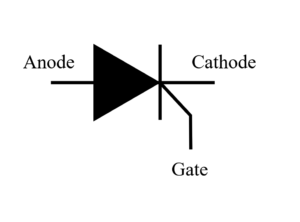Thyristor or SCR (Silicon Controlled Rectifier) Viva Interview Questions and Answers
Question 1: What is an SCR?
Answer: An SCR, or silicon-controlled rectifier, is a four-layer semiconductor device that can be used as a switch. It has three terminals: anode, cathode, and gate. When the gate is not triggered, the SCR is in the off state and no current flows through it. When the gate is triggered, the SCR turns on and current can flow through it.

Question 2: How does an SCR work?
Answer: An SCR works by using the principle of positive feedback. When the gate is triggered, a small current flows through the gate-to-anode junction. This current creates a voltage drop across the junction, which widens the depletion layer. The widening of the depletion layer allows more current to flow through the gate-to-anode junction, which further widens the depletion layer. This process continues until the SCR turns on and current can flow through it without any further input from the gate.
Question 3: What are the different types of SCRs?
Answer: There are many different types of SCRs, but some of the most common types include:
- High-power SCRs: These SCRs are designed for high-current applications, such as motor control and welding.
- Low-power SCRs: These SCRs are designed for low-current applications, such as light dimming and electronic circuits.
- Fast-switching SCRs: These SCRs can switch on and off very quickly, making them suitable for high-frequency applications.
- Gate-turn-off SCRs (GTOs): These SCRs can be turned off by a negative gate pulse, making them more versatile than conventional SCRs.
Question 4: What are the different modes of operation of an SCR?
Answer: There are three modes of operation of an SCR:
- Forward blocking state: This is the state in which the SCR is off and no current flows through it. The anode is positive with respect to the cathode, and the gate is open-circuited.
- Forward conduction state: This is the state in which the SCR is on and current can flow through it. The anode is positive with respect to the cathode, and the gate is triggered.
- Reverse blocking state: This is the state in which the SCR is off and no current flows through it. The anode is negative with respect to the cathode, and the gate is open-circuited.
Question 5: What are the different ways to trigger an SCR?
Answer: There are three main ways to trigger an SCR:
- DC gate triggering: A DC current is applied to the gate to trigger the SCR.
- AC gate triggering: A pulse of AC current is applied to the gate to trigger the SCR.
- Light triggering: A beam of light is shone on the gate to trigger the SCR.
Question 6: How are SCRs protected from overcurrent?
Answer: SCRs can be protected from overcurrent by using a fuse or circuit breaker. The fuse or circuit breaker will open the circuit if the current exceeds the rated current of the SCR.
Question 7: How are SCRs compared to semiconductor devices?
Answer: SCRs are compared to other semiconductor devices such as transistors and diodes. SCRs are similar to transistors in that they can be used as switches. However, SCRs are different from transistors in that they require a gate drive circuit to turn them on. SCR (Silicon Controlled Rectifier) shares similarities with a diode in terms of current flow, SCR allows current to flow in only one direction and blocks it in the opposite direction. Both devices exhibit this unidirectional behavior.
Question 8: What are the different types of snubber circuits?
Answer: There are two main types of snubber circuits:
- Resistive snubber circuits: These circuits use a resistor to absorb the energy from the SCR when it turns off.
- Capacitive snubber circuits: These circuits use a capacitor to absorb the energy from the SCR when it turns off.
Question 9: What are the different types of commutation?
Answer: There are two main types of commutation:
- Natural commutation: This occurs when the current through the SCR goes through zero and the SCR turns off.
- Forced commutation: This occurs when the current through the SCR is forced to zero by an external circuit.
Question 10: What are the applications of SCRs?
Answer: SCRs are used in a wide variety of applications, including:
- Power converters: SCRs are used in power converters to control the flow of power.
- Motor control: SCRs are used to control the speed and direction of rotation of motors.
- Inverters: SCRs are used in inverters to convert DC power to AC power.
- Choppers: SCRs are used in choppers to regulate the voltage or current in a DC circuit.
- Phase control: SCRs are used in phase control circuits to control the power delivered to a load.
Question 11: What are the advantages of SCRs?
Answer: The advantages of SCRs include:
- High efficiency
- Long life
- Low maintenance
- Wide range of applications
Question 12: What are the disadvantages of SCRs?
Answer: The disadvantages of SCRs include:
- Sensitive to transients
- Can be damaged by overcurrent
- Requires a gate drive circuit
SCRs cannot conduct current in both directions.
Thank you for pointing out. It has been corrected.